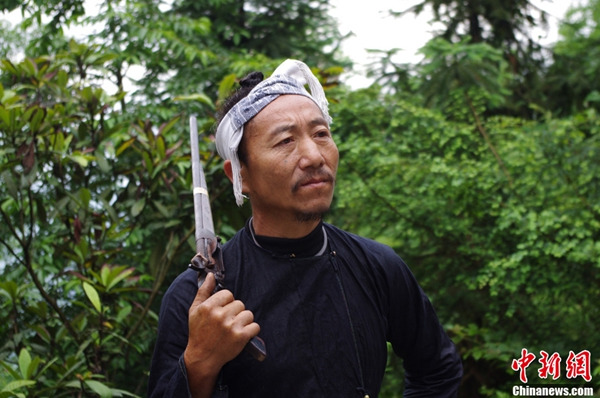
Some 2,500 residents of Basha Miao ethnic village in southwest China continue to preserve the traditional way of life passed down from generation to generation for more than 2,000 years.(Photo/chinanews.com)
Some 2,500 residents of Basha Miao ethnic village in remote Congjiang County of southwest China's mountainous Guizhou Province continue to preserve the Miao people's traditional way of life passed down from generation to generation for more than 2,000 years.
Clad in Miao costumes made of hand-woven cloth, adults wear broadswords in their waistbands and carry fire lances over their shoulders. China's public security authority has given them special permission for gun ownership, but only within the mountains where they live in. They are called the last gun-toting tribe in China.
The Basha people use sickles to cut their hair, worship ancient trees and elemental forces, and have a traditional adult rite after which the young people are entitled to have their own guns that accompany them through life.
At the entrance of the mountain village, rows of villagers wearing silver jewelry and playing traditional musical instruments, greet visitors with rice wine in buffalo horns denoting auspiciousness. The Miao people fire their guns into the sky to welcome visitors from afar, just as the government uses a gun salute to welcome State guests.
The adult ceremony denotes Basha boys have entered adulthood and independence. On the day of the ceremony, the boys can invite their friends to hunt birds in the mountain or catch fish in the river. The more they catch, the more achievements they will have in their life. The birds and fish they catch form the main dish of their ceremonial meal. They drink rice wine, sing ancient Miao songs and perform traditional dances in a carnival atmosphere, after which the tribe's wizard or chief cuts their hair with a sickle, transforming them into "independent household owners". They can then carry the gun their father has made for them to hunt in the mountains and earn their own living and start a family.
The tribal chief cuts off all the boys' hair except for an area on top that is later worn in a bun as an indicator of adulthood, and this hairstyle is kept throughout their life. It is said to be the oldest male hairstyle still seen in China today. Some anthropologists call it the hairstyle of a "living terracotta warrior."
Basha men wear a broadsword on the left of their waist and ox horn powder peg and calabash polished with iron sand on the right, as well as lucky belts on the back of their waists, which are given by their lovers. The more lucky belts a man has, the more female pursuers he has.


















































